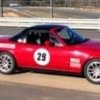Those are very strong dyno results for a 1.6. I guess they exist but I have never seen a 1.6 make anywhere close to 110 torques at 4K or have a peak anywhere near 114 torques at 5600. I never knew I was THAT far from what was considered good. Just my guess but I would guess those results are very optimistic. Would be interesting to see what a good 99 did on the same dyno.

1.6 Data & Testing
#381

 Posted 09-14-2015 11:22 AM
Posted 09-14-2015 11:22 AM

#382

 Posted 09-14-2015 11:34 AM
Posted 09-14-2015 11:34 AM

Danny Steyn,
Curves emailed to you. AFR optimized for both exhausts. We decided against wrapping the header & my attempt at a heat shield was embarrassingly crude so we removed the turn signal to compensate. A number of cars have run this setup but only 1 or 2 have a real chance of winning. If/when they do we will review weights.
I still run my '99 in our sprint series and will run the 1.6 in the ALM Positioners Autobahn Enduro series. Good luck.
Jim Morris
#2, 2X & 722

#383

 Posted 09-14-2015 12:57 PM
Posted 09-14-2015 12:57 PM

Not trying to pick on you Mr. Morris - I can't help but notice the irony.
If a 1.6 wins one race then a weight review is mandated.
Let the NB chassis dominate the past 5-6-8 years and no action is required - "the class has never been closer."
- Alberto likes this


#384

 Posted 09-14-2015 01:25 PM
Posted 09-14-2015 01:25 PM

As stated earlier, our goals are different than what the SCCA's might have been. We don't want to start an arms race at our club, we just want to breath some hope into the existing 1.6 cars and attract even more entrants. Our adjustments are close but likely not perfect. We have the ability to quickly build a consensus and tweak our rules. If we have gone too far, we will add weight. Our top prep cars are 1.8's, if a 1.6 wins in a fair fight either someone has spent a lot of time and money and/or Senna has come back. We are racing for $3 trophies.
- Danny Steyn likes this
Jim Morris
#2, 2X & 722

#385

 Posted 09-14-2015 02:50 PM
Posted 09-14-2015 02:50 PM

#386

 Posted 09-14-2015 03:22 PM
Posted 09-14-2015 03:22 PM

As stated earlier, our goals are different than what the SCCA's might have been. We don't want to start an arms race at our club, we just want to breath some hope into the existing 1.6 cars and attract even more entrants. Our adjustments are close but likely not perfect. We have the ability to quickly build a consensus and tweak our rules. If we have gone too far, we will add weight. Our top prep cars are 1.8's, if a 1.6 wins in a fair fight either someone has spent a lot of time and money and/or Senna has come back. We are racing for $3 trophies.
If you have "gone too far" with the 1.6, would you consider adjusting the others instead of adding weight to the 1.6?

#387

 Posted 09-14-2015 03:39 PM
Posted 09-14-2015 03:39 PM

We have discussed that. We agreed that we wanted to stay as close as possible to SCCA national rules (some members do stray to NASA or SCCA events) and to get the 1.8 guys to agree to let the 1.6's get a little faster, we had to leave the 1.8 cars alone.
(Now if only we could figure out this wheel bearing thing...)
Jim Morris
#2, 2X & 722

#388

 Posted 09-14-2015 04:20 PM
Posted 09-14-2015 04:20 PM

Let the NB chassis dominate the past 5-6-8 years and no action is required - "the class has never been closer."
You forgot the 7.
- Jim Drago likes this



#389

 Posted 09-14-2015 06:02 PM
Posted 09-14-2015 06:02 PM

I know all dynos read differently - 123-124 hp from a 1.6 is the current 'high' normal for cars in the Great Lakes. We ain't taking THAT big of a jump.
You got any data to back that up? Or is this like "Mazda Raceway/Laguna Seca is a 1.6 track" ?
Ok...on average this is what we see on the several dyno's that at some point or another every car in our region will use...
99...125/119
NA1.8...122/115
1.6...120/104
Give or take 1 in each catagory and these numbers are what is winning and I would be confident are legal motors. Certainly seen bigger numbers...but not tuned to last! Just to make a big number on the dyno! Or are questionable??
So hopefully that puts my original comment in perspective!
If a 1.6 could climb the hills at Laguna like the 1.8(no difference)...it would be a 1.6 track Denny!
Ron
RAmotorsports


#390

 Posted 09-14-2015 06:27 PM
Posted 09-14-2015 06:27 PM

"I know all dynos read differently ... "
Yes, Autobahn (Tony Kester) tested and approved 3 dynos, conversion factor ranges from .96 to 1.09!
Obviously, be careful of comparisons.
Jim Morris
#2, 2X & 722

#391

 Posted 09-14-2015 07:21 PM
Posted 09-14-2015 07:21 PM

Yes Jim, that 0.96 to 1.09 looks insignificant enough but don't be fooled, that's a 13% spread on the adjustment of the raw torque numbers!
Ron,
"If a 1.6 could climb the hills at Laguna like the 1.8(no difference)...it would be a 1.6 track Denny!"
If you look at Matt Cresci's (2nd place 1.6) "time to climb the hill" AIM track segment, his best time AIM was 19.257 sec and Steve's (5th place) was 19.346. So based on that it looks like we should now be calling it a 1.6L track. Matt's dyno values taken there were 116 Hp and 102 lb-ft Torque which is also below the 1.6 numbers you listed but in the range. Steves best race lap was a 2:46.710 and I believe Matt's was a 2:46.3..something however the Solo data I got from Matt showed his best lap at 2:46.469. This was due to a power interruption that was happening in his car in the latter laps of the race. If watch his video you can see the lap time display cut out and reset. When this was going on it created segments in the data that were not useful for analysis. There were enough good laps available though to make a comparison.
If you go to the Racing Beat website you can see a lot of dyno data on the development of their header with comparison to production manifolds. I think their data probably represents an apples to apples comparison and does not look like they are trying to inflate the numbers to sell the header.
Rich
- Jim Drago and jdmrrs like this
#392

 Posted 09-14-2015 07:35 PM
Posted 09-14-2015 07:35 PM

I would be interested to know brands/models with that correction factor."I know all dynos read differently ... "
Yes, Autobahn (Tony Kester) tested and approved 3 dynos, conversion factor ranges from .96 to 1.09!
Obviously, be careful of comparisons.
One concern I have is the dyno "weather station" and if the sensors are at least checked occasionally against separate meters. Were weather conditions similar across the tests and were the SAE correction factors close? Location of the temp sensor during testing can be an issue even if you are careful to keep airflow to the engine and intake consistent. I assume that all of the popular shops use ambient rather than placing the probe near the intake?
Sorry, it's a subject of particular interest to me as I have been trying to come up with some sort of correction formula between the popular Dynojets and a Dynapack.


#393

 Posted 09-14-2015 08:26 PM
Posted 09-14-2015 08:26 PM

The shops are Fall-Line, Blackdog and Midwest Eurosport (Joliet shop). It may take me a few days to visit with Tony Kester to get some detailed info or you can call him at Autobahn (tell him we've communicated) or call the shops. All the Miata guys use Eurosport, the GT guys spread it around.
Jim Morris
#2, 2X & 722

#394

 Posted 09-14-2015 08:59 PM
Posted 09-14-2015 08:59 PM

#395

 Posted 09-14-2015 09:06 PM
Posted 09-14-2015 09:06 PM

Too late to write the letter?
If you write it now we should see it by Wednesday
V2 Motorsports
#396

 Posted 09-14-2015 10:33 PM
Posted 09-14-2015 10:33 PM

Rich...the numbers I listed were top to very very good power numbers...here in CA. Matts car along with many other 1.6 cars are(or have been) around what i posted. A few years back SCCA actually had a dyno come to a regional event at Laguna. They ran the top 3 finishers after the first race. 99(won) and 2 1.6 cars(2nd/3rd). Top drivers with top prep cars...
99-119/113
1.6-114/102
1.6-113/101
"average" on paper but close on percentage to what we generally expect between the different year cars.
In your example...More relative might be min and max speeds...and the speed gain differential? Then we know how each car makes its time in the segment.
Ron
RAmotorsports


#397

 Posted 09-15-2015 01:44 AM
Posted 09-15-2015 01:44 AM

Ron- When you lay Matt's speed trace over Steve's there was hardly any difference looking at the trace which is telling me the cars are dynamically very similar. As for the speeds/Time and Distance on track for the run up the hill through Turn 5 accel up hill segment, here is the data;
Lap Time Track Dist Matt MPH Steve MPH
48.234 5383.4 ft 66.3 68.9
58.056 6492.6 85.4 85.3
1:07.666 7699.3 88.7 88.1
1:08.947 7866.7 89.3 89.3
Steve, you had previously asked about the affect of using an 8 lb Aluminum flywheel. I did the Moment of Inertia adjustments and revised the Horsepower table out of the earlier analysis by eliminating the one pound column and adding in what the 8 pound aluminum flywheel would be. That data and some editorial comments on the bottom follow below..
Please use the following Dropbox link as my pasted table formatting didn't hold up.
https://dl.dropboxus...lations v2.docx
The advantages of a rule changing to a lighter flywheel are that every 1.6L entrant who implements an allowed change will obtain the same benefit as any other 1.6L entrant. There are no adjustments that are required nor will it wear out or degrade with use. Nor does it require a perfect engine or calibration.
This is because the horsepower benefit are based on the laws of Physics and there is no technique required in utilizing the advantage. It functions very much like a basic weight adjustment, but it is different in that its advantage increases directly with the engine acceleration rate. This results in it being more beneficial in the lower gear ranges and will particularly help the 1.6L in those situations where their momentum is impeded at the lower speeds when in lower gears where the advantage is maximized.
#398

 Posted 09-15-2015 05:33 AM
Posted 09-15-2015 05:33 AM

Sorry, it's a subject of particular interest to me as I have been trying to come up with some sort of correction formula between the popular Dynojets and a Dynapack.
Steve - Dont bother. Between Drago's Dynojet, Rossini's DynoJet and Fowler's Dynojet we have MASSIVE number differences
A really good 99 on each Dynojet reads as follows
Drago 130 - 121
Rossini 125 - 117
Fowler 126 - 117
And on Fowler's DYnoPack (before he got his Dynojet) the 99 would be 128 - 121
And there are still significant swings on each machine day to day. What is imperative when dynoing cars is to ignore the numbers and look at the area under the curve and to compare the different cars/engines on the same dyno on the same day. Anything other than that is chasing numbers that do not mean anything.
Danny
Danny Steyn Racing | DSR YouTube Channel
Danny Steyn Photography | Adept Studios | Ocean Machinery | OPM Autosports | Rossini Racing Engines | G-Loc Brakes |
2 x SCCA Runoffs Champ | 1 x NASA National Champ | 6 x June Sprints Champ | 10 x ARRC Champ
1 x SCCA Super Sweep | 2 x Triple Crown | 4 x Hoosier Super Tour Points Champ | 6 x Majors Points Champ | 5 x SEDiv Driver of the Year











#399

 Posted 09-15-2015 06:57 AM
Posted 09-15-2015 06:57 AM

Thanks Rich! That's pretty much what we expected. Even in 2nd gear it takes more than trimming the inertia ring to realize just 1hp and to do that in 3rd requires a very light aluminum one. So the 8lb unit looks good in 2nd and probably a decent value to those running certain tracks, but for others running "horsepower" tracks not so much. If I charted the acceleration rates for a lap around someplace like Road America the inertia ring removal would average maybe 0.25 hp and the aluminum one around 0.65 hp, biased towards those few places that are level or downhill in 3rd. It would be interesting to map that at various tracks.


#400

 Posted 09-15-2015 07:17 AM
Posted 09-15-2015 07:17 AM

It's fine to say that you just get the max usable power you can and not worry about absolutes, and focus on the relative gains and losses from various options, but at the end of the day you still want to know whether that gets you close to the rest. So a basic correction factor between mine and say Springfield Dyno and East Street is better than nothing.
If you are seeing big differences in SAE corrected numbers from day to day on the same dyno then there are issues somewhere, either in instrument calibration, testing methodology, or the car. Even between different dynos of the same type you should not see that much difference if done correctly, but it requires effort. I just did a multiple version 8 yr software and CPU upgrade and could not distinguish between runs done two weeks apart before and after.


0 user(s) are reading this topic
0 members, 0 guests, 0 anonymous users




 Sign In
Sign In Create Account
Create Account




 Back to top
Back to top Report
Report



